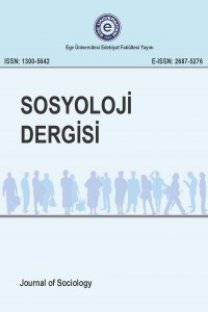Türkiye'de Dindarlık: Kadınların Örtünme Stilleri Üzerine Bir Araştırma
Bu çalışma, şu sorunun cevabını aramaktadır: Kadınların giyinme tarzı ve yoğunluğu dindarlık seviyelerini yansıtıyor mu? Bireylerin dindarlıklarının onların tercih ettikleri giyim tarzları ve örtünme yoğunlukları üzerindeki etkisini ele aldım. Bir anket yardımıyla geliştirdiğim bir ölçeğe dayalı olarak örneklemin dindarlık derecelerini kıyafet tercihlerine bağlı olarak çok boyutlu bir şekilde analiz ettim. Araştırmamın evreni Türkiye'deki genel toplumdur ve özel evreni de kadınlardır. Verilerimi tabakalı rastgele örnekleme tekniğini kullanarak 389 kadından topladım. Bireylerin başlarını ve vücutlarını örtme düzeyleri ile dindarlık dereceleri arasında önemli farklılıklar olduğunu görüyoruz. Ancak dindarlığın tüm boyutlarında önemli bir fark yoktur. Kıyafet tarzı ve derecesi üzerine elde ettiğim bulgularımı ve gelecekteki din araştırmaları üzerindeki etkileri üzerine tartışıyorum.
Anahtar Kelimeler:
Dindarlık, Başörtüsü (Türban), Hicap, Laiklik, Sekülerizm
RELIGIOUSNESS IN TURKEY: A RESEARCH ON COVERING STYLES OF WOMEN
This study seeks the answer to this question: Does the style and degree of women's clothing reflect their level of religiousness? I prefer to determine the religiousness of individuals over their preferred clothing styles and the degrees of covering. Using a questionnaire based on a scale I have developed, I analyzed the degree of religiousness of the participants in a multidimensional manner on depending on their clothes preferences. Universe of my research is the general society in Turkey and the special universe is women. I collected my data from 389 women using stratified random sampling technique. We see that there are significant differences between individuals' levels of covering their head and body and the degree and levels of their religiousness. But there is no significant difference in all dimensions of religiousness. I discuss my findings on the style and degree of clothing and their impact on future research on religion.
Keywords:
Religiousness, Headscraf (Turban), Hijab, Laicism, Secularism,
___
- AKŞİT, B., Şentürk, R., Cengiz, K., Küçükural Ö. 2012. Türkiye'de Dindarlık: Sosyal Gerilimler Ekseninde İnanç ve Yaşam Biçimleri. İstanbul: İletişim Yayınları.
- ARSLAN, Mustafa. 2003. “Popüler Dindarlık Ölçeğinin Geliştirilmesi: Geçerlilik ve Güvenilirlik Çalışması.” Dinbilimleri Akademik Araştırma Dergisi 3 (1): 97-116.
- BARNES, M., Doyle, D., & Johnson, B.. 1989. “The formulation of a Fowler scale: An empirical assessment among Catholics.” Review of Religious Research, 30, 412–420. https://doi.org/10.2307/3511301
- BROWN, D. G., & Lowe, W. L. 1951. “Religious Beliefs and Personality Characteristics of College Students.” The Journal of Social Psychology, 33(1), 103-129. https://doi.org/10.1080/00224545.1962.9919366
- COCHRAN, William G. 1997. Sampling Techniques. New York: Wiley.
- ÇUBUK, Sevgi Uçan. 2012. “The Headscarf Issue in Feminist Discourse in Turkey.” Kadın Araştırmaları Dergisi, Volume: 10. 103-117.
- DENZİN, N. K.. 1992. Symbolic Interactionism and Cultural Studies: The Politics of Interpretation. Malden, MA: Blackwell.
- DEVELLİS, R. F.. 2003. Scale Development Theory and Applications, Second Edition. SAGE, chapter 5: 60-96.
- GLOCK C.Y . 1962. “On the study of Religious Commitment.” Religious Education, 57, 98-110. http://dx.doi.org/10.1080/003440862057S407
- _ _ _. & Stark, R.. 1965. Religion and Society in Tension. Chicago: Rand McNally.
- GÖLE, Nilüfer. 1997. “Secularısm and Islamism in Turkey: The Making of Elites and Counter-Elites.” Middle East Journal. Vol. 51, No. 1, s. 46 58. http://www.jstor.org/stable/4329022
- _ _ _ . 2009. Modernist Kamusal Alan ve İslami Ahlak. (Ed. Nilüfer Göle). İstanbul: Metis Yayınları.
- _ _ _ . 2011. Modern Mahrem. İstanbul: Metis Yayınları.
- _ _ _ . 2012. Seküler ve Dinsel: Aşınan Sınırlar. İstanbul: Metis Yayınları.
- HİLL, C. Peter and Hood, W. Ralph. 1999. Scales of Religiosity. Birmingham, Alabama: Religious Education Press.
- HİMMELFARB, S. Harold. (1975). “Measuring Religious Involvement”. Social Forces 53 (4): 606-618. https://doi.org/10.1093/sf/53.4.606
- ISLAM Ansiclopedia. 2011. Volume 40. 95-105.
- JAMES, W.. 1901. The varieties of Religious Experience. New York: The Modern Library.
- KANBİR, Figen. 2014. “Kadın(ın) T oplumsal Algılamalarındaki Dönüşümü.”Akademik Sosyal Araştırmalar Dergisi, Volume: 1. 72-82.
- KONDA. 2007. “Gündelik Yaşamda Din, Laiklik ve Turban Araştırması.” Milliyet Newspaper. 3-9 September 2007.
- KÖSE, A.. 2002. “Sekülerden Kutsala Yolculuk.” A. Köse (Ed.) in Sekülerizm Sorgulanıyor (pp. 123-222). İstanbul: Ufuk Kitapları
- LEUENBERGER, Kelsey Gabrielle. 2017. “Transformations of the Turkish Headscarf: An Exploration of the Political Meaning, SocioEconomic Impact, Cultural Influence, and the Art and Craft of the Hijab.” Submitted in Partial Completion of the Requirements for Commonwealth Interdisciplinary Honors in Art & Art History and Sociology. Bridgewater State University. Retrieved 31 July 2018 http://vc.bridgew.edu/cgi/viewcontent.cgi?article=1251&context=honors_proj
- LONG, J. Scott and Freese, Jeremy. 2001. Regression models for categorical dependent variables using Stata. College Station, TX: Stata Press.
- ONAY, A.. 2004. Dindarlık, Etkileşim ve Değişim. İstanbul: DEM.
- PARGAMENT, K.I., Ensing, D.S., Falgout, K., Olsen, H., Reilly, B., Van Haitsma, K., & Warren, R.. 1990. “God help me (I): Religious Coping Efforts as Predictors of the Outcomes to Significant Negative Life eEvents.” American Journal of Community Psychology, 18, 793–824. https://doi.org/10.1007/BF00938065
- POLOMA, Margaret M.. 1979. Contemporary Sociological Theory. London: Macmillan Publishing
- SAUNDRA, K. Ciccarelli and J. Noland White. 2013. Psychology: An Exploration. (Seccond Edition). London: Pearson Education.
- SEYHAN, Y . Beyazıt. 2015. “Dinî Şuur Ölçeği: Geçerlilik ve Güvenilirlik Çalışması.” Ekev Akademi Dergisi 19 (61): 399-414.
- YAPICI, Asım.. 2002. “Dini Yaşayışın Farklı Görüntüleri ve Dogmatik Dindarlık.” Ç.Ü. İlahiyat Fakültesi. Dergisi 2 (2). Pp. 75-117.
- WEBER, Max. 2012. The “Objectivity” of Knowledge in Social Science and Social Policy. In: Bruun, H. H. – Whimster, S. (Eds.) Max Weber: Collected Methodological Writings. Oxon : Routledge, 2012.pp.100138.
- ISSN: 1300-5642
- Yayın Aralığı: 2
- Başlangıç: 1987
- Yayıncı: Ege Üniversitesi, Edebiyat Fakültesi
Sayıdaki Diğer Makaleler
EZİLMİŞLİĞİN KADİM HALİ: “YETİMLİK”
Modern Toplumda Bireyin Krizi: Marx, Durkheim ve Weber’in Eserlerinin Bir İncelemesi
MODERN TÜRKİYE’DE SINIRLAR VE SINIRIN SOSYOLOJİK İNŞASI
GEÇMİŞTEN GÜNÜMÜZE CİCERO İLE YAŞLILIK
Türkiye'de Dindarlık: Kadınların Örtünme Stilleri Üzerine Bir Araştırma
